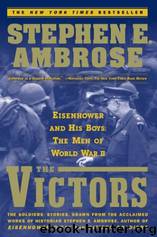The Victors - Eisenhower and His Boys The Men of World War II by Stephen E. Ambrose

Author:Stephen E. Ambrose
Language: eng
Format: epub
The Victors - Eisenhower and His Boys The Men of World War II
12 - Breakout and Pursuit
FROM THE HIGH COMMAND down to the lowliest private, the Americans in Normandy applied everything they had learned to the mounting of Operation Cobra, including a massive air bombardment, forward observers in small planes and at the front lines calling in artillery fire, tanks slicing through hedgerows with their rhinos, and infantry moving forward before the smoke cleared, not pausing to help a wounded buddy or ducking behind a bit of shelter and letting the others go ahead. The shock of the bombardment and the elan of the infantry were sufficient to drive the Germans from their positions. The breakthrough was a great feat of arms. First Army had accomplished something that had been nearly impossible in 1914-1918, and not achieved by the British in front of Caen in June-July 1944. First Army had accomplished something that it had not been trained or equipped to do, in the process developing an air-ground team unmatched in the world. Now, along with Third Army, it was finally going to get into a campaign for which it had been trained and equipped. The dean of American military historians, Russell Weigley, referring to the flow of GIs that poured around the German open flank, writes in his classic study Eisenhower’s Lieutenants, “This virtual road march was war such as the American army was designed for, especially the American armored divisions. Appealing also to the passion for moving on that is so much a part of the American character and heritage, it brought out the best in the troops, their energy and mechanical resourcefulness. . . .
“Now that Cobra had achieved the breakout, the most mobile army in the world for the first time since D-Day could capitalize on its mobility.” Weigley further notes that with the hard-won mobility, “the issues confronting the army became for the first time in Europe strategic rather than tactical. The soldiers’ battle of Normandy was about to become the generals’ battle of France.” With the German left flank in the air, and the Allies facing an open road to Paris, Patton was activated and all his pent-up energy turned loose. He had come over in time for Cobra, to familiarize himself with the situation and to set up Third Army headquarters. He took command of one of the corps already in Normandy and had other divisions coming in from England.* By August 1, he had divisions attacking in four directions. Meanwhile First Army pressed forward to the south as German resistance collapsed.
When Third Army was activated, Gen. Courtney Hodges succeeded Bradley as First Army commander while Bradley moved up to command Twelfth Army Group (First and Third Armies).
As the general German retreat began, the American air-ground team pounded the enemy. The Wehrmacht was out of the hedgerows, out in the open, trying desperately to move by day to get away. Patton’s tanks mauled them, the Jabos (the German term for the Allied fighter-bombers) terrorized them.
Download
This site does not store any files on its server. We only index and link to content provided by other sites. Please contact the content providers to delete copyright contents if any and email us, we'll remove relevant links or contents immediately.
| Books & Reading | Comparative Literature |
| Criticism & Theory | Genres & Styles |
| Movements & Periods | Reference |
| Regional & Cultural | Women Authors |
4 3 2 1: A Novel by Paul Auster(11053)
The handmaid's tale by Margaret Atwood(6857)
Giovanni's Room by James Baldwin(5881)
Big Magic: Creative Living Beyond Fear by Elizabeth Gilbert(4727)
Asking the Right Questions: A Guide to Critical Thinking by M. Neil Browne & Stuart M. Keeley(4579)
On Writing A Memoir of the Craft by Stephen King(4216)
Ego Is the Enemy by Ryan Holiday(3994)
Ken Follett - World without end by Ken Follett(3975)
The Body: A Guide for Occupants by Bill Bryson(3803)
Bluets by Maggie Nelson(3714)
Adulting by Kelly Williams Brown(3674)
Guilty Pleasures by Laurell K Hamilton(3588)
Eat That Frog! by Brian Tracy(3515)
White Noise - A Novel by Don DeLillo(3437)
The Poetry of Pablo Neruda by Pablo Neruda(3369)
Alive: The Story of the Andes Survivors by Piers Paul Read(3314)
The Bookshop by Penelope Fitzgerald(3230)
The Book of Joy by Dalai Lama(3220)
Fingerprints of the Gods by Graham Hancock(3215)
